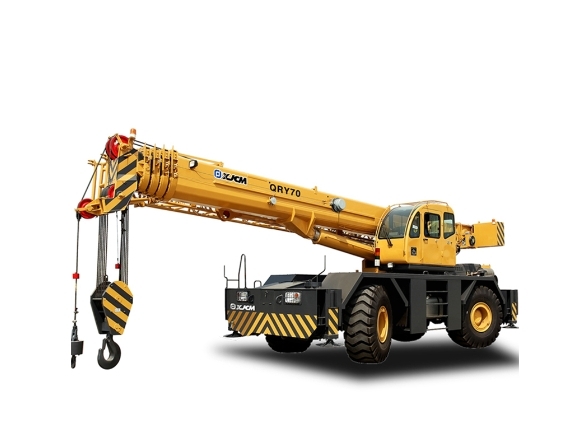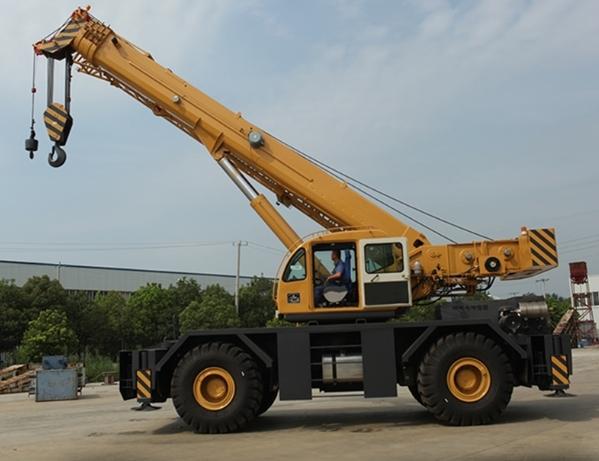What is a Rough Terrain Crane? Rough terrain cranes are versatile, heavy-duty machines used in construction, infrastructure development, and industrial projects. These specialized cranes are designed to tackle challenging off-road terrains, making them an indispensable asset in situations where traditional cranes would be less effective. The key feature that sets rough terrain cranes apart is their ability to navigate rugged landscapes while carrying heavy loads, all while ensuring stability and precision in lifting and placement.
What is a Rough Terrain Crane? Exploring the Versatile 70 Ton Mobile Rough Terrain Crane
1. What is a Rough Terrain Crane? Unveiling the 70 Ton Mobile Rough Terrain Crane
What is a Rough Terrain Crane? The 70 Ton Mobile Rough Terrain Crane is a remarkable piece of machinery that can venture off the beaten path. With its robust construction and impressive load-bearing capacity, it’s the go-to choice for heavy lifting in challenging environments. Whether you’re navigating through construction sites filled with uneven terrain or managing operations on oil rigs located far from shore, this crane is up to the task.

2. What is a Rough Terrain Crane? Efficiency and Power on Rough Terrain
One of the standout features of the 70 Ton Mobile Rough Terrain Crane is its remarkable efficiency. It’s equipped with a powerful engine that ensures smooth operation even in the toughest conditions. The crane also boasts a high-quality hydraulic system, providing precise control over its movements, and allowing operators to maneuver heavy loads with precision and safety.
3. What is a Rough Terrain Crane? Operator Comfort and Safety
Operating heavy machinery is no small feat, but the 70 Ton Mobile Rough Terrain Crane makes it more manageable. Inside its spacious cab, operators enjoy excellent visibility and a comfortable working environment, ensuring efficiency and safety in every job. Safety is paramount, and this crane is equipped with essential features, including a load moment limiter and a control system that guarantees safe and efficient operations.
4. What is a Rough Terrain Crane? Key Components and Features
The 70 Ton Mobile Rough Terrain Crane consists of two main components: the superstructure and the undercarriage. The superstructure handles the lifting duties, featuring a telescopic boom, jib, main winch, and aux. winch, luffing mechanism, counterweight, and swivel table. The undercarriage, on the other hand, encompasses suspension and walking components, with a slewing ring connecting it to the superstructure.
5. What is a Rough Terrain Crane? Versatile Off-Road Performance
This crane offers remarkable versatility with features like front-wheel steering, rear-wheel steering, four-wheel steering, crab steering, and all-wheel drive, making it highly adaptable for off-road travel. The German-engineered KESSLER+CO axles include a differential lock for enhanced stability. The American Mico brake system ensures reliable stopping power.
6. What is a Rough Terrain Crane? Maneuverability and Compact Design
The 70 Ton Mobile Rough Terrain Crane is designed for narrow spaces and offers a small turning radius, enhancing its maneuverability in challenging environments. It can operate in all directions without outriggers, a feature that significantly improves its usability in tight spaces.
7. What is a Rough Terrain Crane? Wide Applications
With its mobility, robust design, and adaptability, the 70 Ton Mobile Rough Terrain Crane is widely employed in the construction, oil and gas, and logistics industries. It serves as a crucial tool in various projects, from erecting buildings to handling heavy equipment and materials in remote areas.
Now Understanding What is a Rough Terrain Crane? Let’s Choose the Right Rough Terrain Crane
Do you know What is a Rough Terrain Crane? So now, let’s select the right rough terrain crane is a pivotal decision for any project manager or construction professional. To make an informed choice, one must consider a range of factors that ensure the crane meets the specific needs and demands of the project. Here’s a guide to help you navigate the decision-making process when it comes to rough terrain cranes:

1. Capacity
The first and foremost factor to consider when choosing a rough terrain crane is its lifting capacity. This refers to the maximum weight the crane can hoist safely. XJCM, a reputable provider of rough terrain cranes, offers a variety of models with different weight capacities, making it crucial to assess the heaviest loads your project will require. It’s advisable to opt for a crane with a slightly higher capacity than what you anticipate needing to account for unexpected changes or variations in the workload.
2. Reach
The crane’s reach, often referred to as its boom length or radius, is the horizontal distance it can extend while maintaining the ability to lift loads. Understanding your project’s requirements is essential to selecting the right reach for your crane. XJCM’s rough terrain cranes offer a range of boom lengths to accommodate different needs. Consider factors such as the height of the structures you’ll be working on and how far you need to reach, ensuring the crane’s boom can meet these demands.
3. Mobility
The ability of a rough terrain crane to maneuver over challenging terrains is one of its defining features. When selecting a crane, evaluate the terrain where your project is located. Rocky, muddy, or uneven ground demands a crane with exceptional mobility. XJCM’s rough terrain cranes are engineered to handle various landscapes, but it’s crucial to choose a model that matches the specific environment in which you’ll be working.
4. Terrain Considerations
Rough terrain cranes excel in off-road environments, but the specific terrain characteristics are vital in determining the crane’s performance. Consider the following terrain factors:
Mud and Soft Soil: If your project site has muddy or soft soil, you may need outriggers to provide additional stability. XJCM offers rough terrain cranes with adjustable outriggers to help distribute the crane’s weight and prevent sinking.
Uneven Terrain: For rugged, uneven terrain, look for a crane with all-terrain capabilities. XJCM’s cranes are designed to handle a variety of terrains, making them an excellent choice for such environments.
Sloped Surfaces: If your project involves working on slopes or inclines, ensure the crane has features like grade ability and secure anchoring systems to prevent any accidents or tipping.
5. Cost and Budget
While cost is a practical consideration, it’s crucial not to compromise safety and performance for a cheaper option. Calculate your budget and evaluate the return on investment a rough terrain crane can offer for your project. XJCM provides a range of models with varying price points to suit different budgets while maintaining high-quality standards.
Conclusion
Selecting the right rough terrain crane is a critical decision that can significantly impact the success of your project. By taking into account factors like capacity, reach, mobility, and terrain considerations, you can ensure that the crane you choose will meet the unique demands of your project. What is a Rough Terrain Crane? With XJCM’s selection of rough terrain cranes, you can confidently make a choice that combines reliability, durability, and value for your construction or industrial needs.



